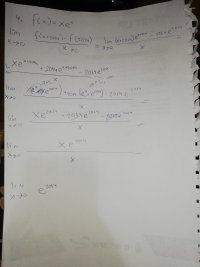You are using an out of date browser. It may not display this or other websites correctly.
You should upgrade or use an alternative browser.
You should upgrade or use an alternative browser.
Limits confusion
- Thread starter Loki123
- Start date
What? I am supposed to get 2015e^2014Why are you doing all this work? The limit equals f'(2021).
Okay, what do I do then?3rd line from the bottom is wrong. Let0, represent not 0--some number other than 0.
0/0= 0, that is a true 0/0= 0. However something approaching 0 divided by something approaching 0 is not necessarily 0
Steven G
Elite Member
- Joined
- Dec 30, 2014
- Messages
- 14,383
So you are not getting f'(2014) = 2015e^2014 or did you not try? I suspect that it is the latter, so just try and you'll see that you get the correct answer.What? I am supposed to get 2015e^2014
Rewrite your limit with one change--replace x with h. Then decide if you see that the limit equals f'(2014)
Steven G
Elite Member
- Joined
- Dec 30, 2014
- Messages
- 14,383
Recognize that the limit is simply f'(2014). That is what the author wanted you to do with this exercise.Okay, what do I do then?
I am having trouble understanding you. The limit's solution is supposed to be 2015e^2014, i tried to solve the problem and got e^2014.So you are not getting f'(2014) = 2015e^2014 or did you not try? I suspect that it is the latter, so just try and you'll see that you get the correct answer.
Rewrite your limit with one change--replace x with h. Then decide if you see that the limit equals f'(2014)
IRecognize that the limit is simply f'(2014). That is what the author wanted you to do with this exercise.
What does f' have to do here, please explain?So you are not getting f'(2014) = 2015e^2014 or did you not try? I suspect that it is the latter, so just try and you'll see that you get the correct answer.
Rewrite your limit with one change--replace x with h. Then decide if you see that the limit equals f'(2014)
D
Deleted member 4993
Guest
How's that?The limit equals f'(2021).
Steven G
Elite Member
- Joined
- Dec 30, 2014
- Messages
- 14,383
Fine, the limit equals f'(2014). Are you happy now? Happy New Year!How's that?
BigBeachBanana
Senior Member
- Joined
- Nov 19, 2021
- Messages
- 2,181
Have you learned l'Hopital's rule?
Steven G
Elite Member
- Joined
- Dec 30, 2014
- Messages
- 14,383
To see that the limit is f'(2014) you need to do as I say. Please rewrite the limit using h instead of x. Post back that limit and we will go from there.I
What does f' have to do here, please explain?
Steven G
Elite Member
- Joined
- Dec 30, 2014
- Messages
- 14,383
The student need to recognize that this is a limit of the quotient function which is simply a derivative.Have you learned l'Hopital's rule?
YessHave you learned l'Hopital's rule?
I would like to realize that but I am not even sure I know what a quotient function is.The student need to recognize that this is a limit of the quotient function which is simply a derivative.
BigBeachBanana
Senior Member
- Joined
- Nov 19, 2021
- Messages
- 2,181
Jomo meant that you can compute the derivative of f(x) using the product rule and evaluate it in 2014. Why do you need to do it through the definition of the derivative?Why are you doing all this work? The limit equals f'(2014).
Jomo is saying here that it's not x->inf; you should use another variable to indicate the "steps" size, typically h.3rd line from the bottom is wrong. Let0, represent not 0--some number other than 0.
0/0= 0, that is a true 0/0= 0. However something approaching 0 divided by something approaching 0 is not necessarily 0
If you insist on using the definition of limit, then I'd recommend using l'Hospital's rule. First, you need to recognize why it's applicable.
Steven G
Elite Member
- Joined
- Dec 30, 2014
- Messages
- 14,383
I meant to say the difference quotient. It is the quotient used in the definition of a derivative.I would like to realize that but I am not even sure I know what a quotient function is.
Seriously, instead of just saying that you don't see what I am saying or that you don't understand what I am saying why not take my advice and rewrite the limit with two minor changes--replace 2014 with a and x with h. Then it will look exactly like the derivative formula. You need to simple practice noticing the pattern.

